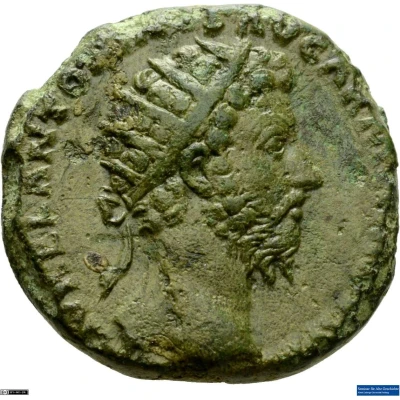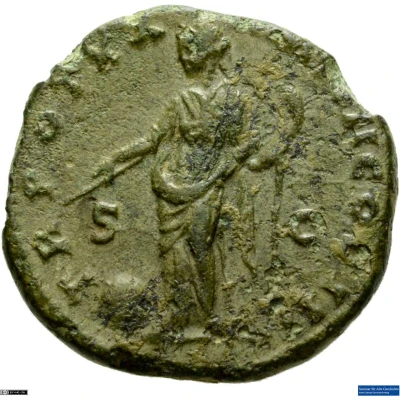Dupondius - Marcus Aurelius TR P XX IMP III COS III S C; Roma
| Bronze | - | - |
| Issuer | Rome › Roman Empire (27 BC - 395 AD) |
|---|---|
| Emperor | Marcus Aurelius (Marcus Aurelius Antoninus) (161-180) |
| Type | Standard circulation coin |
| Years | 165-166 |
| Value | 1 Dupondius = ⅛ Denarius |
| Currency | Denarius, Reform of Augustus (27 BC – AD 215) |
| Composition | Bronze |
| Shape | Round (irregular) |
| Technique | Hammered |
| Demonetized | Yes |
| Updated | 2024-10-06 |
| Numista | N#263620 |
|---|---|
| Rarity index | 100% |
Reverse
Roma, helmeted, draped, seated left, holding palladium in right hand and spear in left hand; behind her, shield.
Script: Latin
Lettering: TR P XX IMP III COS III S C
Translation:
Tribunicia Potestate Vicesima, Imperator Tertium, Consul Tertium. Senatus Consultum.
Holder of tribunician power for the 20th time, supreme commander (Imperator) for the third time, consul for the third time. Decree of the senate.
Comment
Source:Online Coins of the Roman Empire (OCRE)
Interesting fact
The Dupondius coin was a bronze coin introduced by the Roman Empire during the reign of Marcus Aurelius (161-180 AD). It was equal in value to two sestertii or one-fourth of a denarius, which was the standard silver coin of the time. The Dupondius coin was widely used throughout the Roman Empire and remained in circulation for over 200 years, until the reign of Emperor Diocletian (284-305 AD). The coin's design featured the image of the emperor on one side and various gods, goddesses, and other symbols on the other side. In the case of the Dupondius coin , the obverse (front) side features the bust of Marcus Aurelius, while the reverse (back) side features the goddess Roma seated on a throne, holding a spear and a shield. The inscription "TR P XX IMP III COS III S C" on the coin stands for "Tribunicia Potestate XX, Imperator III, Consul III, Senatus Consulto" which translates to "Tribune of the Plebeians for the 20th time, Emperor for the 3rd time, Consul for the 3rd time, by decree of the Senate". Overall, the Dupondius coin is an interesting piece of history that provides insight into the economy, politics, and culture of the Roman Empire during the 2nd century AD.



